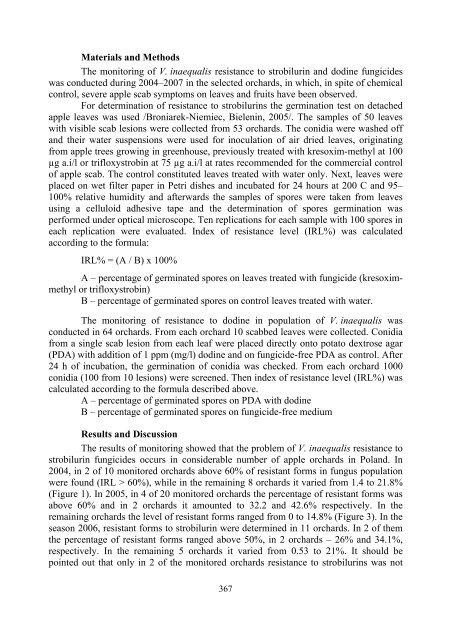Resistance of Venturia inaequalis to strobilurin and dodine
Resistance of Venturia inaequalis to strobilurin and dodine
Resistance of Venturia inaequalis to strobilurin and dodine
Create successful ePaper yourself
Turn your PDF publications into a flip-book with our unique Google optimized e-Paper software.
Materials <strong>and</strong> Methods<br />
The moni<strong>to</strong>ring <strong>of</strong> V. <strong>inaequalis</strong> resistance <strong>to</strong> <strong>strobilurin</strong> <strong>and</strong> <strong>dodine</strong> fungicides<br />
was conducted during 2004–2007 in the selected orchards, in which, in spite <strong>of</strong> chemical<br />
control, severe apple scab symp<strong>to</strong>ms on leaves <strong>and</strong> fruits have been observed.<br />
For determination <strong>of</strong> resistance <strong>to</strong> <strong>strobilurin</strong>s the germination test on detached<br />
apple leaves was used /Broniarek-Niemiec, Bielenin, 2005/. The samples <strong>of</strong> 50 leaves<br />
with visible scab lesions were collected from 53 orchards. The conidia were washed <strong>of</strong>f<br />
<strong>and</strong> their water suspensions were used for inoculation <strong>of</strong> air dried leaves, originating<br />
from apple trees growing in greenhouse, previously treated with kresoxim-methyl at 100<br />
µg a.i/l or trifloxystrobin at 75 µg a.i/l at rates recommended for the commercial control<br />
<strong>of</strong> apple scab. The control constituted leaves treated with water only. Next, leaves were<br />
placed on wet filter paper in Petri dishes <strong>and</strong> incubated for 24 hours at 200 C <strong>and</strong> 95–<br />
100% relative humidity <strong>and</strong> afterwards the samples <strong>of</strong> spores were taken from leaves<br />
using a celluloid adhesive tape <strong>and</strong> the determination <strong>of</strong> spores germination was<br />
performed under optical microscope. Ten replications for each sample with 100 spores in<br />
each replication were evaluated. Index <strong>of</strong> resistance level (IRL%) was calculated<br />
according <strong>to</strong> the formula:<br />
IRL% = (A / B) x 100%<br />
A – percentage <strong>of</strong> germinated spores on leaves treated with fungicide (kresoximmethyl<br />
or trifloxystrobin)<br />
B – percentage <strong>of</strong> germinated spores on control leaves treated with water.<br />
The moni<strong>to</strong>ring <strong>of</strong> resistance <strong>to</strong> <strong>dodine</strong> in population <strong>of</strong> V. <strong>inaequalis</strong> was<br />
conducted in 64 orchards. From each orchard 10 scabbed leaves were collected. Conidia<br />
from a single scab lesion from each leaf were placed directly on<strong>to</strong> pota<strong>to</strong> dextrose agar<br />
(PDA) with addition <strong>of</strong> 1 ppm (mg/l) <strong>dodine</strong> <strong>and</strong> on fungicide-free PDA as control. After<br />
24 h <strong>of</strong> incubation, the germination <strong>of</strong> conidia was checked. From each orchard 1000<br />
conidia (100 from 10 lesions) were screened. Then index <strong>of</strong> resistance level (IRL%) was<br />
calculated according <strong>to</strong> the formula described above.<br />
A – percentage <strong>of</strong> germinated spores on PDA with <strong>dodine</strong><br />
B – percentage <strong>of</strong> germinated spores on fungicide-free medium<br />
Results <strong>and</strong> Discussion<br />
The results <strong>of</strong> moni<strong>to</strong>ring showed that the problem <strong>of</strong> V. <strong>inaequalis</strong> resistance <strong>to</strong><br />
<strong>strobilurin</strong> fungicides occurs in considerable number <strong>of</strong> apple orchards in Pol<strong>and</strong>. In<br />
2004, in 2 <strong>of</strong> 10 moni<strong>to</strong>red orchards above 60% <strong>of</strong> resistant forms in fungus population<br />
were found (IRL > 60%), while in the remaining 8 orchards it varied from 1.4 <strong>to</strong> 21.8%<br />
(Figure 1). In 2005, in 4 <strong>of</strong> 20 moni<strong>to</strong>red orchards the percentage <strong>of</strong> resistant forms was<br />
above 60% <strong>and</strong> in 2 orchards it amounted <strong>to</strong> 32.2 <strong>and</strong> 42.6% respectively. In the<br />
remaining orchards the level <strong>of</strong> resistant forms ranged from 0 <strong>to</strong> 14.8% (Figure 3). In the<br />
season 2006, resistant forms <strong>to</strong> <strong>strobilurin</strong> were determined in 11 orchards. In 2 <strong>of</strong> them<br />
the percentage <strong>of</strong> resistant forms ranged above 50%, in 2 orchards – 26% <strong>and</strong> 34.1%,<br />
respectively. In the remaining 5 orchards it varied from 0.53 <strong>to</strong> 21%. It should be<br />
pointed out that only in 2 <strong>of</strong> the moni<strong>to</strong>red orchards resistance <strong>to</strong> <strong>strobilurin</strong>s was not<br />
367


